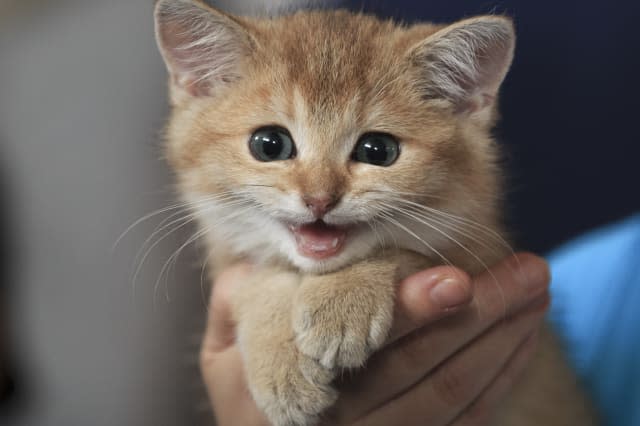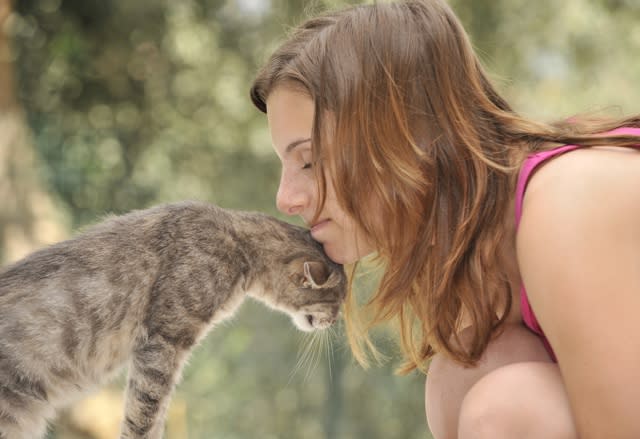What your cat is really thinking

Your cat is part of the family but they're creatures of mystery - after all, she can't talk to you and tell you what they're really thinking.
Or can she? You might be surprised to learn that many things your moggy does is in fact a way of communicating with you.
That moment you find a dead mouse in the middle of the kitchen floor? That's a sign your cat's secure at home.
And did you know it's not only dogs that 'wag' their tails? When your cat is really pleased to see you, she will hold its tail straight in the air, and it will quiver or twitch.
With the help of Evy Mayes, Battersea Dogs & Cats Home Cattery Rehomer, we've found out more about what your cat's really thinking below:
1. "Give me some attention!"

Eva says cat behaviour researchers have identified 19 different vocal patterns in cats, which can be categorised into 3 groups: meowing, purring and hissing. A basic meow needs to be interpreted in the context of the situation. It could mean, "let me out", or "feed me". Purring, which occurs from a vibration in the wall of one of the major blood vessels in the chest, is usually a sign of contentment or a greeting. Hissing, on the other hand, is a warning sign to back off. Evy adds: "Cats are very clever with their meow. A lot of cats learn that if they meow they are rewarded with something they want, such as food or being stroked from their owner."

2. "I'm scared"
A cat that feels threatened or frightened may yowl, hiss and arch its back. It may also seem edgy and look for places to hide - under beds. Certain triggers can cause this, including strangers in the house, moving, fireworks, trips to the vet. A cat calming spray which releases a synthetic copy of the phemerone they produce to mark their territory when they feel comfortable in their environment can help in these situations. Try Feliway Spray or the herb-infused CatCalm, for example.
3. "I'm happy"

Did you know that when a cat rubs on your legs, it's a sign of ownership as well as affection? "Cats like to mark their territory, and use pheromone-filled scent glands to communicate with other cats," Evy explains. "Bonded cats from the same social group mutually rub each other on the face and body and do this to deposit each other's scent on one another. As a result of this, a unique scent is created within the social group to make all the cats feel safe and secure in their environment."
4. "Here's a present for you"

A cat is a born predator as it has evolved to hunt, says Evy. Even though we feed our cats at home, a cat may still have the innate predatory drive/motivation to go and hunt. Evy says it's a good sign if your cat brings you these 'gifts': "If your cat brings prey back home, this suggests that it feels safe in its home territory and therefore it can leave food there without the worry that it will be stolen!"
If you'd rather your cat laid off the present-giving, you could invest in a collar with a bell like this Dotty collar from Tesco - it will help alert unsuspecting creatures including birds that there is a predator on the loose.
5. "I knead you"

When kittens are born, they knead their mother's teats to stimulate her milk flow in order to survive, explains Evy, adding: "Many cats knead their owners lap when they are enjoying their owner's affection, suggesting that it is enjoying the secure nature of the moment as it would as a kitten to its mum". Awww.
5. Telling tails

"A cat's tail position is an important visual signal used in cat communication," says Evy. Straight up? Your cat's proud and happy as Larry. Horizontal? They're relaxed and confident (and possibly prowling). A high hooked tail indicates a level of uncertainty about another cat or person, while a quivering high tail means they're extremely pleased to see you. A swishing tail could mean your cat's annoyed, and a puffy or bristled high tail means its fearful and could become aggressive.
For more cat tips, see our video below:




